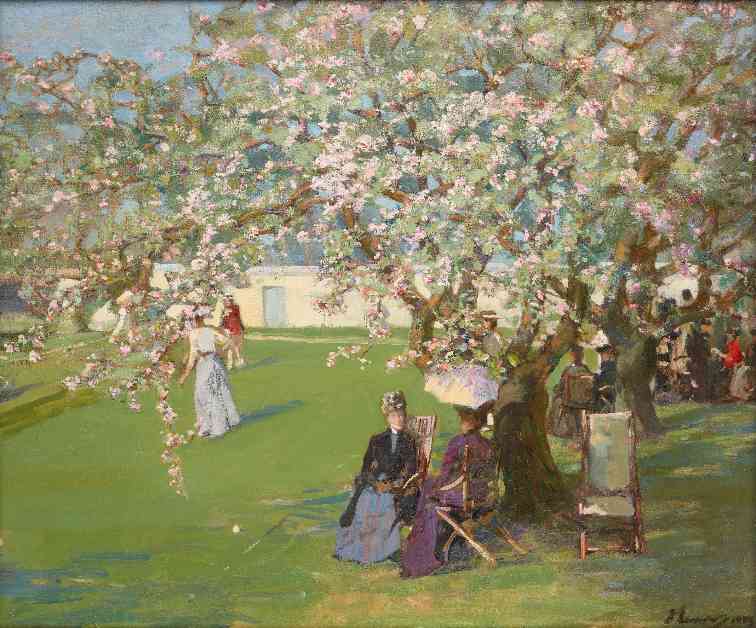Paisley Painting Auctioned for Over £500k in £1M Fundraiser
A stunning painting that was part of the Paisley Art Institute collection recently went up for auction, fetching an impressive sum of over half a million pounds. The painting, created by renowned artist Sir John Lavery, captures a scene of Paisley socialites enjoying a tennis party in the year 1899. The exquisite piece of art was sold for a remarkable £537,700, showcasing the enduring appeal and value of historical artworks.
Notable Sales and Artistic Significance
The auction featured a selection of works from the prestigious Paisley Art Institute collection, titled ‘Taste for Art: Selected Works from the Paisley Art Institute Collection’. Apart from Sir John Lavery’s captivating painting, other notable sales included Scottish Colourist F.C.B Cadell’s portrait titled Pink and Gold, which sold for an impressive £250,200. Additionally, George Henry’s Banks of Allan Water triptych was acquired by a Scottish collector for £237,650 in a private sale, ensuring that the artist’s original vision for the connected pieces was preserved.
One of the highlights of the auction was the sale of Sir James Gutherie’s The Stonebreaker for £75,200, showcasing the diverse range of artworks that were part of the collection. Each piece represented a unique aspect of Scottish art history, contributing to the overall success of the fundraiser. The total proceeds from the auction exceeded expectations, with the art selling for a total of £1.63 million, significantly surpassing the initial target of £1 million.
Preserving Artistic Heritage and Future Plans
The Paisley Art Institute has been a longstanding pillar of the artistic community, supporting and showcasing artists across Scotland for 148 years. The recent auction served as a crucial step in securing the institute’s future, with a substantial portion of the funds raised contributing to ongoing efforts to sustain the artist-led charity. The success of the auction reaffirmed the importance of preserving and promoting Scotland’s artistic heritage for future generations to appreciate and enjoy.
Following the auction, the buyer of Sir John Lavery’s painting expressed a desire for the artwork to be displayed in a public institution, further emphasizing the significance of these historical pieces in the cultural landscape. The PAI President, Joe Hargan, lauded the sale of George Henry’s triptych as a testament to the enduring value of the artist’s concept and expressed gratitude to the patron for upholding the integrity of the work.
Challenges and Collaborations
Despite the success of the auction, the Paisley Art Institute faced challenges in its relationship with Paisley Museum during the institution’s refurbishment. Disagreements arose over the allocation of gallery space for the PAI collection, with conflicting claims regarding contractual agreements and exhibition opportunities. The PAI’s decision to decline the offer of the Balcony Gallery within the museum underscored the importance of preserving the institute’s autonomy and heritage.
In response to the concerns raised by the PAI, OneRen, the organization overseeing the museum refurbishment, emphasized the inclusive nature of the museum and its commitment to reflecting the diverse artistic legacy of Paisley. The ongoing dialogue between the PAI and OneRen aimed to find common ground in showcasing the town’s rich artistic heritage while balancing the needs of the broader community.
With the recent opening of Paisley Museum, the PAI has forged a partnership with the Glasgow Art Club, relocating its collection to the club’s premises on Bath Street. This strategic move will enable the PAI to continue its mission of supporting artists and preserving Scotland’s artistic legacy while adapting to the evolving cultural landscape. The proceeds from the auction will play a vital role in meeting the rising costs associated with maintaining and promoting the institute’s collection.
In conclusion, the successful auction of the Paisley Art Institute collection exemplifies the enduring value and significance of historical artworks in preserving Scotland’s artistic heritage. The collaborative efforts between the PAI, OneRen, and the Glasgow Art Club highlight the importance of fostering partnerships to sustain and promote artistic endeavors. By navigating challenges and embracing opportunities for growth and collaboration, the PAI continues to uphold its legacy as a beacon of artistic excellence in Scotland.















